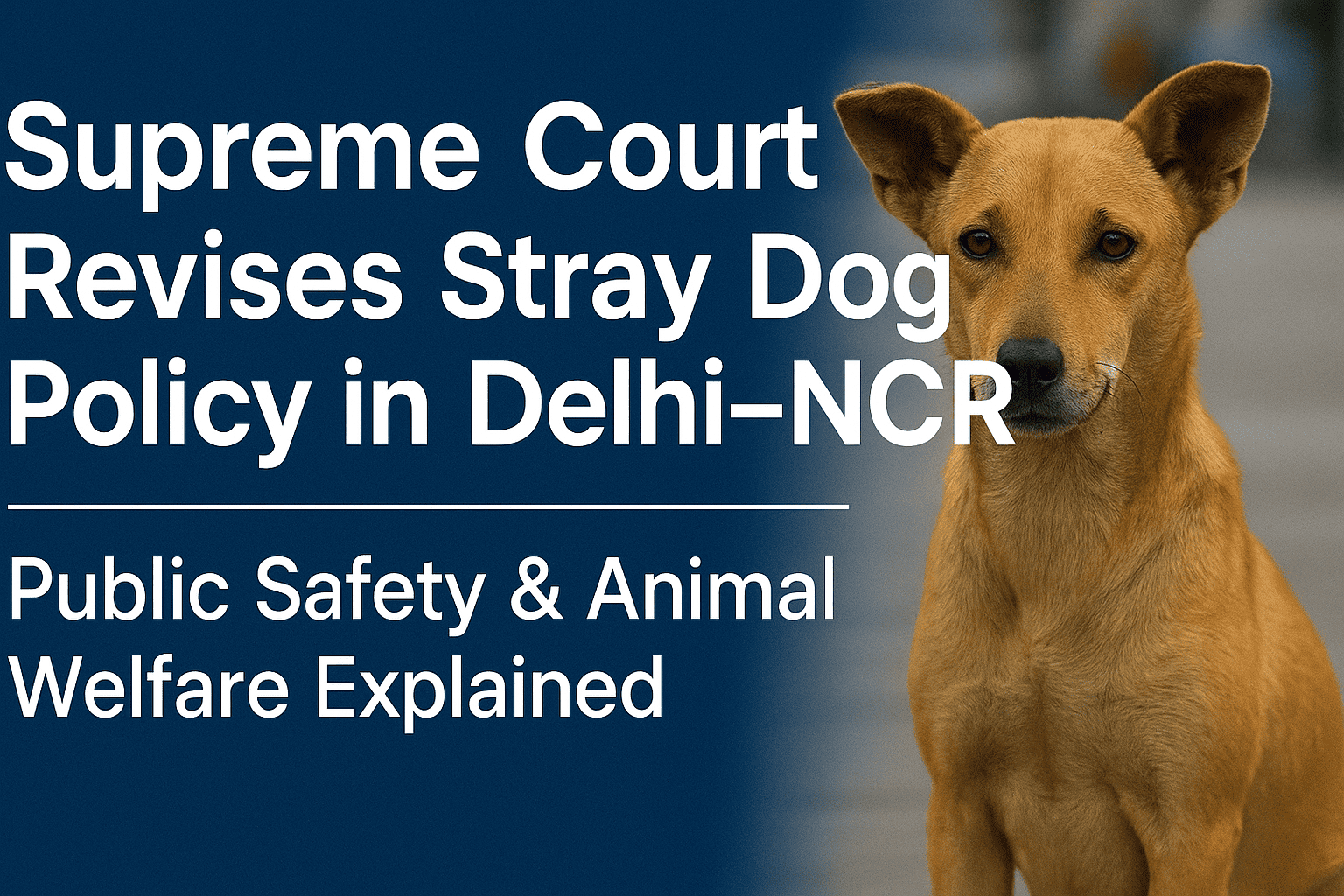The issue of stray dogs in India has been a subject of heated debate for decades. With millions of stray animals roaming freely on streets, both public safety and animal welfare have remained in constant conflict. On August 2025, a landmark decision was made when the Supreme Court revises stray dog policy in Delhi–NCR, aiming to create a balance between human concerns and animal rights.
This essay explores the key implications of the ruling, the challenges ahead, and why this decision represents a milestone in India’s judicial and civic journey.
Background of Stray Dog Issues in India
India is estimated to have more than 60 million stray dogs, making it one of the largest populations of street animals in the world. Rabies remains a persistent threat, with thousands of reported cases annually. Complaints about dog bites, public safety, and unsanitary conditions have clashed with campaigns led by animal rights activists who argue against culling and cruelty.
For years, courts have been pulled into the debate, resulting in fragmented orders. The latest ruling, however, attempts to create a structured, uniform approach.
Supreme Court’s Revised Stray Dog Policy
In its August 2025 order, the Supreme Court revises stray dog policy in Delhi–NCR by allowing sterilised and vaccinated stray dogs to be released back into their original territories.
Key highlights of the policy:
-
Sterilised dogs can return to their areas, unless they are aggressive or rabid.
-
Dedicated feeding zones must be created to prevent conflicts.
-
State-wide helplines will be launched for reporting dog-related emergencies.
-
A ₹2,500 crore fund has been allocated to support sterilisation, vaccination, and shelter management.
-
All states and union territories are directed to form a uniform policy for stray animal management.
Supreme Court Revises Stray Dog Policy in Delhi–NCR
The phrase “Supreme Court revises stray dog policy in Delhi–NCR” is not just a legal headline but also a focus keyword representing larger themes of urban governance, civic order, and human-animal coexistence.
By embedding this keyword in discussions, we ensure that the narrative is both search-friendly for digital readers and contextually informative for policymakers, animal lovers, and citizens.
Public Health and Safety Concerns
One of the strongest arguments for regulation comes from public health. According to the National Rabies Control Programme, India accounts for 36% of the world’s rabies deaths. Stray dogs are often carriers, and unmanaged populations can increase risks.
The new policy seeks to balance:
-
Protecting citizens from bites and rabies
-
Preventing cruelty against dogs
-
Ensuring safe urban spaces for children, elderly, and commuters
Animal Welfare and Rights Perspective
Animal rights groups, including PETA India and People for Animals, have welcomed the ruling as it reaffirms the Animal Birth Control (ABC) Rules, 2023. Releasing sterilized dogs back into their environment reduces overpopulation without resorting to culling, which is both inhumane and legally prohibited.
For activists, the fact that the Supreme Court revises stray dog policy in Delhi–NCR by endorsing sterilization rather than extermination is a victory for compassion.
Government Responsibility and Implementation Challenges
The biggest challenge is implementation. Sterilisation programs require trained vets, infrastructure, and coordination between municipal bodies. Delhi–NCR already struggles with waste management, traffic, and air pollution; adding animal control will demand efficient governance.
Moreover, corruption, lack of awareness, and limited funds in smaller municipalities could derail progress unless monitored closely.
Comparison with Global Stray Dog Management Policies
Globally, countries have adopted different strategies:
-
Turkey has city-run shelters and sterilization drives.
-
Romania faced international backlash for mass culling in the 2010s.
-
Thailand runs Buddhist temple-based adoption and feeding programs.
By comparison, when the Supreme Court revises stray dog policy in Delhi–NCR, it leans closer to the humane sterilization-first model seen in progressive countries.
Funding and Infrastructure for Implementation
The ₹2,500 crore fund is significant but requires transparent allocation. Cities must invest in:
-
Modern animal birth control (ABC) centres
-
Vaccination drives in schools and localities
-
Technology-enabled helplines and reporting apps
-
Public awareness campaigns on safe coexistence
Role of Civil Society and NGOs
NGOs like FriendCo’s, Blue Cross India, and local welfare groups will play a crucial role. The Supreme Court has recognised that citizen involvement is essential—from reporting aggressive animals to volunteering for adoption drives.
Impact on Local Communities
Residents of Delhi–NCR have mixed reactions. While many welcome safer streets, others fear continued nuisance if sterilisation is not carried out effectively. Housing societies may need to designate feeding zones, which could spark disputes between dog feeders and residents.
Media Coverage and Public Reactions
Indian media has framed the ruling as a “middle path” solution. Social media, however, reflects polarisation—urban families concerned about bites vs. activists celebrating humane treatment.
Long-Term Benefits of the Supreme Court’s Policy
If implemented correctly, benefits include:
-
Reduction in stray dog population over 5–10 years
-
Lower rabies deaths
-
Improved civic safety
-
Better human-animal coexistence
Criticism and Possible Loopholes
Critics argue that:
-
Returning dogs to original locations may not satisfy fearful residents
-
Lack of municipal accountability could make sterilisation data unreliable
-
Enforcement of feeding zones may fail in crowded areas
These challenges suggest the policy needs constant monitoring and adjustments.
Conclusion: Why the Supreme Court Revises Stray Dog Policy in Delhi–NCR Matters
In essence, the Supreme Court revises stray dog policy in Delhi–NCR to strike a balance between public safety and animal rights. The decision recognises that stray dogs are part of the urban ecosystem, but their population must be controlled humanely. [READ MORE]
This ruling will influence not only Delhi–NCR but also inspire nationwide policies. It highlights how law, governance, and compassion can work together in addressing urban challenges.
By placing citizens and animals at the heart of policymaking, India has taken a significant step towards sustainable urban living.
